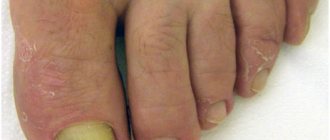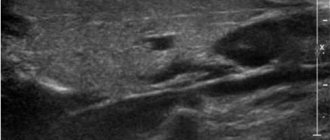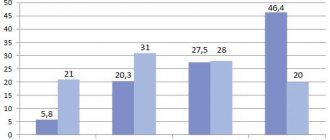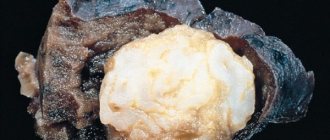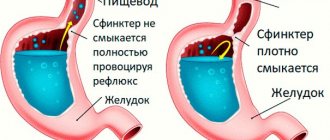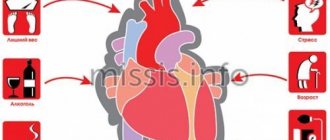A cramp is a painful tonic spasm that is sometimes mistakenly called a cramp. Part of the muscle or the entire muscle can contract. The duration of contraction ranges from several seconds to several minutes. The syndrome develops more often at night in rest and warmth, when the opposing muscles - antagonists - are relaxed. Quite often, muscle spasms are preceded by fasciculations, clearly visible to the eye in the daytime. The attack passes with clear consciousness, there are no associated disorders. Crumpy practically does not occur in children under 8 years of age, but after 65 years of age the frequency increases sharply. In older people, tonic muscle contractions impair the quality of sleep or cause insomnia.
The frequency of muscle involvement is distributed as follows:
- muscles of the leg and foot;
- biceps brachii;
- extensors of the fingers;
- muscles of the trunk and diaphragm;
- submandibular
A distinctive feature of crampy is severe pain that occurs at the moment of muscle spasm, which stops when it ends. During spasm, the muscle becomes dense and sharply painful when touched. Every 10th person suffers from crampy on a regular basis.
At CELT you can get advice from a neurologist.
- Initial consultation – 4,000
- Repeated consultation – 2,500
Make an appointment
Why does a cramp occur?
The causes are physiological (primary) and pathological (secondary). Relatively safe physiological causes are muscle strain, as well as temporary metabolic disorders.
In a healthy person, muscle cramps are provoked by the following factors:
- unusual long-term, high-intensity exercise;
- non-physiological muscle tension caused by diseases of the spine and joints of the limbs;
- alcohol abuse;
- insufficient sleep;
- smoking;
- violation of the temperature regime - overheating or hypothermia;
- water and electrolyte disturbances (excessive sweating in the heat, insufficient fluid intake, use of diuretics and medications);
Pathological causes of crampy are various diseases and conditions of the organs and nervous system. These include:
- diseases of peripheral nerves – radiculo- and polyneuropathy;
- Parkinson's disease;
- diseases of the central nervous system - spinal amyotrophy, amyotrophic lateral sclerosis, consequences of poliomyelitis;
- multiple sclerosis;
- liver diseases, especially chronic hepatitis and cirrhosis;
- intestinal diseases, especially viral enteritis;
- kidney disease, especially chronic renal failure with uremia;
- muscle diseases – muscular dystrophies, metabolic myopathies;
- endocrine diseases - diabetes mellitus, hypothyroidism, decreased function of the parathyroid glands;
- growth and development of tumors, benign and malignant;
- iron deficiency in the body;
- obliterating diseases of the vessels of the lower extremities;
- heart failure accompanied by edema;
- pregnancy.
Cramps can develop after blood purification operations - hemodialysis and plasmapheresis. In some cases, the cause of convulsive contractions cannot be detected; such conditions are called idiopathic.
There are familial forms when cramps occur in adolescence or old age for no apparent reason. Such forms have a wave-like course and spread to the muscles of the thighs and anterior abdominal wall. A spasm of the mylohyoid muscle is characteristic when, after yawning, its unilateral contraction develops. Researchers believe that the mechanism of hereditary transmission of this form is autosomal dominant. Many people associate cramps with a deficiency of vitamins B and D, as well as electrolytes.
Causes
When they talk about muscle blocks, they usually mean tension in the muscles of the neck and back: trapezius, rhomboid major, quadratus lumbar, latissimus dorsi and others. Back muscle spasms occur with the following pathologies:
- Severe stress.
Stress affects the functioning of the endocrine system, which causes an increase in muscle tone. - Spinal injuries.
With spinal bruises, a trigger point may be affected - the area of the muscle that is most sensitive to irritants, and when squeezed, severe pain occurs. - Chronic overexertion.
Appears when the back is incorrectly positioned during prolonged sitting or standing work. Also, overstrain of the back muscles occurs when constantly carrying a bag on one shoulder. - Osteochondrosis
and its complications - protrusions and hernias. With osteochondrosis, nerve tissue is pinched, which causes spasms in the muscles.
Diagnostic principles
Only a doctor can distinguish a physiological reaction from a pathological condition; it is impossible to do this on your own.
You should not worry only if cramps occur rarely, no more than once a month, and the cause “lies on the surface”, there is a clear connection with physical overload, profuse sweating or other “natural” reasons mentioned above. In all other cases, you need to see a doctor as early as possible to rule out diseases or adjust your medication intake. Particularly noteworthy are long, protracted convulsive contractions that are repeated.
Sometimes muscle tightness and soreness last for several days. An indirect confirmation of long-term cramps is an increase in the level of creatine phosphokinase. Tonic spasm of the muscles of the chest or diaphragm is rare, but can create a picture of a heart or lung infarction.
Careful diagnosis is the basis for successful treatment. Due to the variety of reasons, the examination may take about a week. The diagnostic equipment of the CELT clinic allows us to identify hidden diseases that a person did not know about. An important aspect is the determination of homeostasis indicators and their possible deviations from the norm. The identified changes in water-electrolyte metabolism make it possible to quickly correct the condition.
A set of diagnostic procedures may include, if necessary, not only general clinical tests, but also electroneuromyography, studies of the function of the heart, thyroid gland, kidneys and other organs. ENMG outside an attack can reveal signs of primary muscle pathology and disruption of muscle innervation; high-frequency and amplitude potentials are recorded during muscle contraction.
It is known that cramps occur more often in people with “thick” calves or some hypertrophy of these muscles. Researchers attribute this to the large amount of myoglobin in them (the so-called “red muscles”). It is interesting that among peoples who spend a lot of time squatting and thus constantly straining their calf muscles, cramps are observed much less frequently. However, prolonged stay in this position can lead to pinching of the peroneal nerve.
general characteristics
Various convulsive syndromes rank third in terms of overall incidence in the population after cardiovascular pathology and diabetes mellitus.
They account for 20% of all neurological disorders. Pathological symptoms more often occur in children (up to 15 years) and old age. Cramps are felt as involuntary spastic contractions of skeletal muscles - individual muscle groups or the entire body - of varying intensity, short-term or long-term. They arise spontaneously or are provoked by acute pathology or the action of external factors. Severe convulsive twitching of the muscles of the limbs and torso disrupts musculoskeletal function, leading to falls and injuries. Spastic tension is painful, often accompanied by arching or turning of the body, deviation of the head and eyes to one side. Tonic-clonic seizures are manifested by disturbances of consciousness and breathing, urinary incontinence, some are preceded by focal neurological symptoms. Single episodes have a favorable prognosis, but frequent seizures disrupt habitual activity and reduce the patient’s quality of life.
Our doctors
Belikov Alexander Valerievich
Neurologist, Candidate of Medical Sciences
21 years of experience
Make an appointment
Novikova Larisa Vaganovna
Neuropathologist, Candidate of Medical Sciences, doctor of the highest category
Experience 39 years
Make an appointment
Pankov Alexander Rostislavovich
Neurologist
40 years of experience
Make an appointment
Signs
Medical experts call epilepsy the main disease leading to convulsive syndrome. The approach of a tonic attack can be predicted in advance by several signs: hearing and smell become more acute, and an unpleasant taste appears in the mouth. Epileptics fall into unconsciousness and scream or howl loudly. The muscles experience extreme tension: the jaws tighten, breathing becomes difficult, the face turns blue. The duration of the attack does not exceed 3-5 minutes. After the muscles relax, a sleepy state sets in, and the person is unable to remember what happened.
Treatment rules
Crumpies themselves do not pose a threat to life or health. However, they are extremely painful and cause a lot of trouble. The symptoms accompanying cramps are varied, so the efforts of the doctors at the CELT clinic are aimed at identifying the underlying disease. Treatment of this disease, as well as the abolition of excess medications, can quickly improve health outcomes.
Emergency relief for pain relief consists of passive stretching of the contracted muscle or voluntary active contraction of the antagonist muscle. So, when there is a cramp in the calf muscle, you need to stand up, leaning on the irritated leg, and when the muscles of the fingers contract, straighten them with your hand.
To prevent cramps after physical activity, you need to raise your legs high from a lying position. In this position, venous outflow improves and the likelihood of convulsive contraction decreases. If electrolytes are lost through sweat or diarrhea, potassium and magnesium supplements are recommended.
Physiotherapy is used as an auxiliary method, in particular the following methods:
- physical therapy aimed at general strengthening of muscles;
- contrast water procedures, massage and hardware types of physiotherapy.
If the effect of physiotherapeutic procedures is insignificant, the doctor may prescribe medication.
How to eliminate pain and numbness?
If you suddenly have severe cramps in your legs, what should you do ? The first thing you need to do is pull your toes towards you or press your foot firmly to the floor. Often muscle spasms appear during a night's sleep and the person wakes up. Sit carefully, press your hands to the disturbing area and massage vigorously until this unpleasant sensation goes away. Then raise your legs higher to reduce blood pressure. If you suddenly have severe cramps in your legs, what should you do in a crowded place? Close the muscle tightly with your fingers and hold until the pain goes away.
Prevention
Giving up bad habits, streamlining your lifestyle and nutrition are the basic principles of prevention. Along with this, moderate physical activity is useful - walking or exercising on an exercise bike. It’s good to do simple muscle stretching exercises in your free time. At any time of the year you need to drink a sufficient amount of clean water - 30 ml per kilogram of weight in the cool season and 50 ml in the hot season.
For those who experience frequent cramps, it is advisable to reduce the consumption of drinks containing a lot of caffeine and stop smoking. When sleeping, you need to cover yourself warmly, especially keep your feet warm.
The best prevention of cramps, as well as other disorders, is an examination that can be completed at the CELT multidisciplinary clinic at any time.
Make an appointment through the application or by calling +7 +7 We work every day:
- Monday—Friday: 8.00—20.00
- Saturday: 8.00–18.00
- Sunday is a day off
The nearest metro and MCC stations to the clinic:
- Highway of Enthusiasts or Perovo
- Partisan
- Enthusiast Highway
Driving directions
Determination of tonic muscle spasms
Tonic cramps are unconscious muscle contractions that appear due to severe and sharp pain. There are three types of seizures: clonic, tonic, and tonic-clonic. To accurately determine the type of seizure in a person, timely diagnosis is necessary. Seizures are not always dangerous, but prompt treatment is necessary. An incorrectly functioning body signals that disturbances are occurring within it. In acute forms of the disease, convulsions are considered a factor in blocking the airways and stopping the heart.
Differences between clonic and tonic seizures
A specific feature of tonic spasms is the sudden tension of all muscles. The body is held in a tense state for a long time. The cause of tonic seizures lies in the cerebral cortex. Convulsions can overtake the patient in his sleep if he was very active the day before. Spasms usually do not affect the facial muscles, respiratory system and arms.
Clonic seizures vary in frequency. Severe spasms are replaced by temporary relaxation. Irregular spasms occur on the face and hands. The torso is involved in a convulsion if the patient has developed attacks of epilepsy. Tonic and clinical convulsions occur alternately in acute epilepsy.
Localized and generalized tonic seizures
Generalized convulsions : convulsions of the torso, limbs and lungs are added to muscle arrhythmia. The arms twist unnaturally, but the lower limbs remain in a relaxed state. The entire body is under extreme tension. The jaw closes tightly due to the tension on the face, and the head tilts towards the back. A person under such tension is rarely conscious. Generalized tonic convulsions are combined with epileptic seizures. A similar effect can occur due to the penetration of a toxic substance into the body.
Localized seizures are characterized by a paralytic effect on only one part of the body. Contractions do not occur constantly, but in portions, with short intervals. During localized convulsions, the person remains conscious. It is necessary to eliminate the source of irritation and provide rest for the body. No special medical skills are required to eliminate such seizures.

